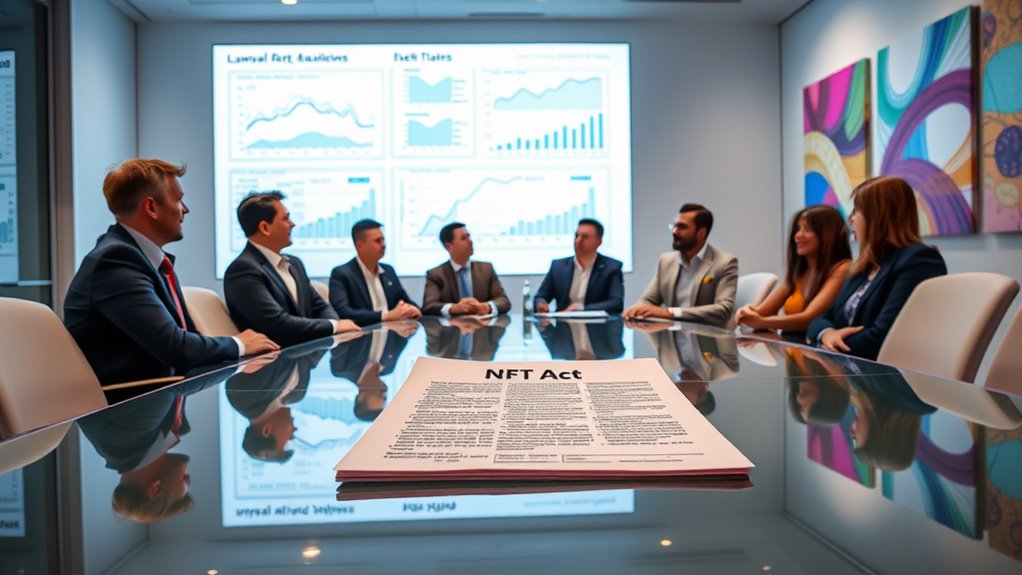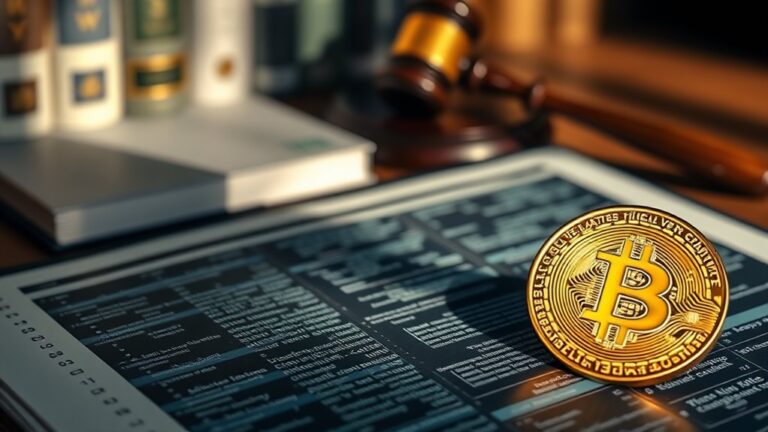
NFT Regulations: What You Need to Know Now
Current NFT regulations remain complex and evolving across jurisdictions. In the US, the SEC uses the Howey test to determine if NFTs are securities, while proposed legislation like the NFT Act aims to exempt art and collectible NFTs from securities classification. Creators face ordinary income tax obligations, while investors encounter capital gains considerations. Internationally, regulatory approaches vary greatly, with some countries implementing stricter oversight than others. Understanding these frameworks is essential for market participants maneuvering this digital frontier.
Key Takeaways
- The SEC classifies certain NFTs as securities using the Howey test, targeting projects that promise future value or resale royalties.
- NFT creators face ordinary income tax on sales, while investors encounter capital gains taxes based on holding periods.
- The proposed NFT Act aims to exempt art and collectible NFTs from securities classification, potentially reducing regulatory burden.
- Global NFT regulations vary significantly, with the EU excluding unique NFTs from MiCA while the US applies securities laws.
- Proper record-keeping and understanding current enforcement actions are essential as regulatory frameworks continue to evolve rapidly.
The NFT Act and Securities Law Implications

As the non-fungible token (NFT) market continues to evolve, legislators have introduced the NFT Act to address the complex regulatory landscape surrounding these digital assets.
The Act aims to exclude certain NFTs, particularly those functioning as art and collectibles, from being classified as securities.
NFTs representing art and collectibles would gain exemption from securities classification under the proposed legislation.
Under current frameworks, NFTs classified as securities must comply with registration requirements, creating significant legal obligations for creators and marketplaces.
The Howey test remains the primary method for determining if an NFT constitutes an investment contract.
If enacted, the NFT Act would provide much-needed clarity by establishing consistent regulatory standards.
The implications are substantial—marketplaces could avoid registering as securities exchanges, and creators would face reduced liability for misrepresentations.
Meanwhile, the SEC continues its enforcement-based approach while industry players challenge its jurisdiction.
SEC’s Enforcement Strategy and Current Legal Framework

The SEC’s approach to NFT regulation has drawn significant attention from market participants and legal experts alike. Rather than providing clear guidelines, the agency has adopted a “regulation-by-enforcement” strategy, selectively targeting projects like Impact Theory and Flyfish Club for allegedly selling unregistered securities.
The SEC primarily applies the Howey test to determine if NFTs constitute investment contracts, focusing on factors such as resale royalties and promises of future value.
This enforcement-first approach has created uncertainty within the industry. Without consistent standards, NFT creators and marketplaces struggle to understand their compliance obligations.
Recent cases highlight how smart contracts facilitating royalty payments may trigger securities classifications. Dissenting commissioners have called for clearer rules instead of selective enforcement actions that leave much of the market guessing about compliance requirements.
Tax Considerations for NFT Creators and Investors

Three distinct tax frameworks apply to NFT participants depending on their role in the marketplace. Creators face ordinary income taxes on sales and potential self-employment taxes if operating as a business. Investors encounter capital gains taxes that vary based on holding periods. Meanwhile, platforms must meet specific reporting requirements.
| Role | Tax Classification | Primary Tax | Key Considerations |
|---|---|---|---|
| Creator | Ordinary Income | Income Tax + Self-employment | Deductible creation costs |
| Investor | Capital Asset | Capital Gains | Long vs. short-term rates |
| Trader | Business Income | Ordinary Income | Higher transaction frequency |
| Collector | Collectible Asset | Up to 28% for long-term | Special collectible rates |
Proper record-keeping remains essential for all participants, as the IRS continues refining its approach to digital assets. Strategic planning, including timing sales and considering donation options, can greatly impact tax obligations.
International Regulatory Approaches to Digital Collectibles

Global approaches to NFT regulation vary markedly as nations wrestle with how to classify and oversee these unique digital assets.
Regulatory frameworks reflect different priorities across jurisdictions, with some emphasizing financial stability while others focus on consumer protection.
Major regulatory approaches include:
- FATF Guidelines – Considers NFTs as Virtual Assets if used primarily for payment or investment purposes
- EU Approach – Generally excludes unique NFTs from MiCA regulations but may include them under AMLD 6
- US Framework – SEC may classify NFTs as securities if they resemble investment contracts; IRS treats them as property
- UK Position – Most NFTs are classified as unregulated tokens unless they exhibit characteristics of e-money or security tokens
The lack of global consensus on NFT classification—whether as commodities, securities, or intellectual property—continues to challenge regulatory efforts.
Future Outlook: Navigating the Evolving NFT Legal Landscape

As regulatory frameworks continue to evolve globally, NFT participants face a complex and uncertain legal landscape that requires careful navigation. The pending New Frontiers in Technology Act and potential shifts in political administration may bring much-needed clarity to the industry. Moreover, as seen in the broader crypto space, increased trust and institutional partnerships are becoming essential for fostering a sustainable market.
| Regulatory Area | Current Challenge | Future Direction |
|---|---|---|
| Securities Laws | SEC “regulation-by-enforcement” | Legislative definition of “covered NFTs” |
| Money Laundering | Limited KYC/AML practices | Expanded BSA application by FinCEN |
| Legal Status | Uncertainty under Howey Test | Comptroller General study results |
| Compliance | Reactive approaches | Proactive risk assessment |
| Innovation | Regulatory constraints | Balance between oversight and growth |
Stakeholders should implement compliance measures while monitoring legislative developments. The tension between innovation and regulation will likely remain a defining characteristic of the NFT landscape as authorities work to address both consumer protection and market growth.
Frequently Asked Questions
How Do Smart Contracts Affect Legal Enforceability of NFT Transactions?
Smart contracts provide automaticity and immutability to NFT transactions, but their legal enforceability varies by jurisdiction and depends on meeting traditional contract elements like offer, acceptance, consideration, and intent.
Can NFT Platforms Be Held Liable for User Copyright Infringement?
Like mirrors reflecting unauthorized content, NFT platforms can be liable for user copyright infringement based on their knowledge, monitoring practices, and response to takedown notices, though liability varies by jurisdiction and platform involvement.
What Insurance Options Exist for Protecting Valuable NFT Collections?
Insurance options for NFT collections remain limited, with some providers offering smart contract coverage, digital asset protection, and custody risk policies. Most are developing or available through specialized crypto insurers and adapted cyber policies.
How Do Ownership Disputes Resolve When Blockchain Records Conflict?
Like Gordian knots awaiting Alexander’s sword, blockchain conflicts typically resolve through specialized arbitration or court litigation. These processes examine transaction timestamps, consensus mechanisms, and off-chain evidence to determine legitimate ownership claims.
Are Environmental Regulations Impacting NFT Minting Processes and Platforms?
Environmental regulations are increasingly influencing NFT platforms, with many adopting carbon offset strategies and shifting to eco-friendly blockchains like Solana. Anticipation of future regulations drives innovation toward greener minting processes and sustainability practices.
Conclusion
As NFT regulations continue to evolve, investors and creators navigate a landscape that shifts like desert sands beneath their feet. The intersection of securities law, tax obligations, and international frameworks creates a complex tapestry of compliance requirements. Those who stay informed of regulatory developments, seek appropriate professional guidance, and adapt their strategies accordingly will be best positioned to weather the storms of this dynamic digital frontier.












